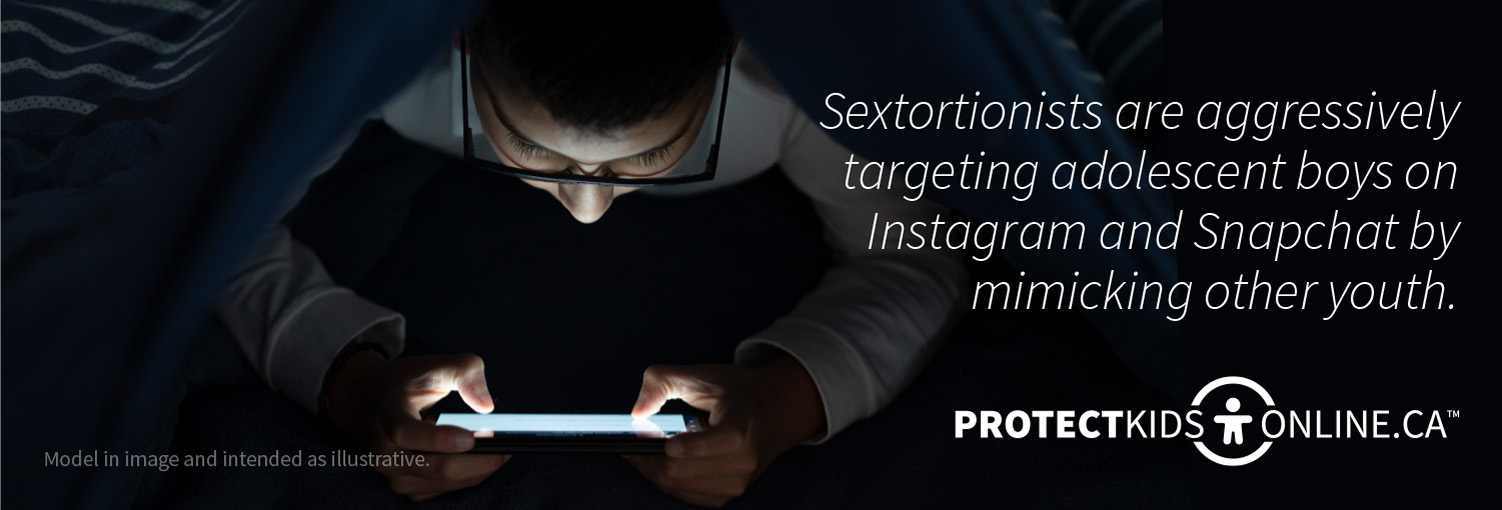Reports of boys falling prey to sextortion scams climb

Cybertip.ca, Canada’s tipline for reporting the online sexual exploitation of children, has found that adolescent boys are being heavily targeted on Instagram® and Snapchat® as part of an ongoing sextortion crisis.
The Canadian Centre for Child Protection (C3P), which operates Cybertip.ca, received an unprecedented volume of reports from youth, and sometimes their concerned parents, about falling prey to aggressive sextortion tactics over the past few weeks. In August alone, Cybertip.ca opened case files for 322 victims of sextortion.
Of these cases:
- 52 per cent of victims were under 18;
- 84 per cent involved boys or young men when the gender of the victim was known; and
- 57 per cent of victims reported they didn’t disclose the incident to someone they trusted.
Data collected by C3P also found that when victims disclosed the platforms used to facilitate the harm, Instagram (42 per cent) and Snapchat (38 per cent) were by far the most frequently used social media platforms where victims were targeted. This suggests that offenders seek out children where they can be easily found: the social platforms they engage with for hours each day.
 Social media accounts may look credible because of their follower counts, profle photos, or details shared in their bios.
Social media accounts may look credible because of their follower counts, profle photos, or details shared in their bios.
HOW ARE TEENS AND YOUNG MEN TARGETED ON POPULAR SOCIAL MEDIA PLATFORMS?
Sextortionists used two distinct tactics in the majority of the cases reviewed by Cybertip.ca, and both begin with youth being tricked into believing they are interacting with someone their age. The conversation is quickly turned sexual, and if a victim sends an intimate image, the offender behind the account often immediately makes aggressive demands for money or more images while threatening to release the images to the victim’s family and friends.
The analysis also showed an emerging tactic where the victim is sent nude images of children from the person behind the fake account. The offender will then threaten to report the victim to police, claiming they are in possession of child sexual abuse material. Demands for money immediately follow.
WHAT SHOULD CAREGIVERS DO IF THEIR CHILD IS BEING SEXTORTED?
- Report it. If you think your child might be in immediate danger or risk, call 911. In all other instances, report what has happened to police or to Cybertip.ca through the online report form or via the toll free number at 1-866-658-9022.
- Do not comply with the threat. In other words, never pay money and ensure your teen never sends additional images/videos. Youth may feel inclined to negotiate with offenders, but Cybertip.ca data shows that giving into any demand in any capacity tends to lead to additional requests from the offender.
- Stop all communication with the person making the threat. Stalling the offender or returning their aggression doesn’t help. The quicker you cut off the offender, the more likely they will lose interest and move on.
- Keep any correspondence between your teen and the person threatening them.

HOW CAN I HELP MY TEEN PROTECT THEMSELVES ON SOCIAL MEDIA PLATFORMS, LIKE SNAPCHAT AND INSTAGRAM?
- Talk with your teen about only adding people/followers they know in real life. On Snapchat, encourage your teen to block random/unknown users who add them.
- Tell your teen not to click on or access links/websites sent to them through direct messages, especially if they don’t know the individual sending the link.
- Encourage your teen to create strong passwords for their social accounts.
- Remind your teen to limit the amount of information about themselves in their profile details. Instagram bios should not include information about their interests, location, or age. Snapchat profiles have the option to include users' full names, their birthday, and star sign. Encourage teens to use a pseudonym and disable Birthday Party, which will remove their birthday details. Learn more about how to ensure your teen’s social media bio isn’t giving away too much personal information.
- Let your teen know that material in their “My Eyes Only” section of their Snapchat account is not as secure as they may think and to carefully consider what is stored/shared there.
- Encourage your teen not to share their Snapcode™ (a unique QR code that allows people to quick add users to their Snapchat) or other social media usernames online.
-
Work with teens on their privacy settings, including:-
For Snapchat:
- Review the “Who Can” section under Settings to modify and limit who can contact your teen, view their stories, see them in Quick Add, and see their location.
-
For Instagram:
- Enable “Supervision” with your teens permission to have access to their following and followers list, and to be notified when they get new followers. Parents can send an invite to use “Supervision” to their child under Settings.
- Enable “Limits,” to limit comments and messages from unwanted groups (Limits can be found under Settings > Privacy).
- Review who can view or reply to their Instagram story (found under Settings > Privacy > Story).
- Review who they can receive messages from (found under Settings > Privacy > Message Controls).
-
For Snapchat:
- Have regular conversations about online safety — talk about the apps they use, games they play, and who they’re connecting with. For tips on how to get the conversation started with kids and teens of all ages, visit protectkidsonline.ca.
- Remind teens they can always come to you for help if something has happened without fear of getting in trouble or losing their device.
For more information on sextortion, visit Cybertip.ca.